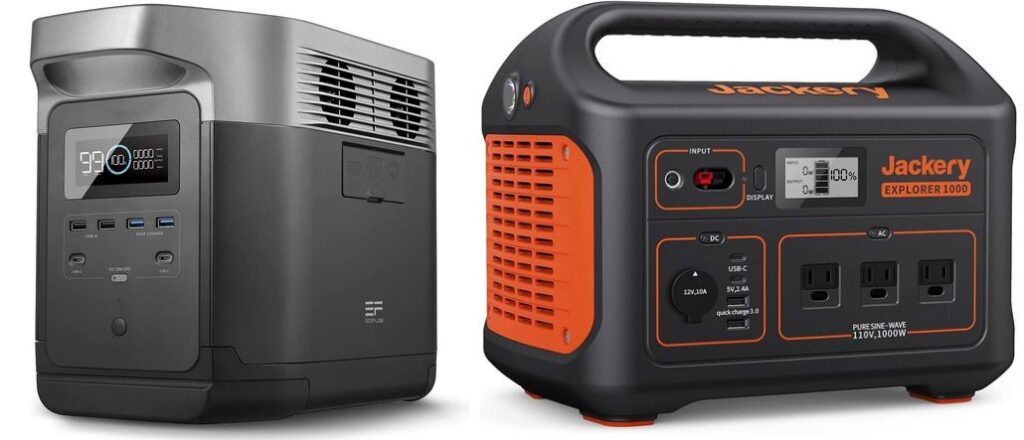Choosing between the EcoFlow Delta 1300 and the Jackery Explorer 1000?
You’ve come to the right place.
Both are mid-size solar generators powerful enough to run some appliances yet portable enough to take outdoors on camping trips and other adventures.
But there are key differences between them including power output, capacity, and charging speed.
In this one-on-one matchup, we compare the EcoFlow Delta 1300 vs. the Jackery Explorer 1000 to help you choose the right one for your power needs.EcoFlow Delta 1300 vs. Jackery Explorer 1000 Compared
Let’s kick off with a quick comparison between the two power stations.
EcoFlow Delta 1300 | Jackery 1000 |
|---|---|
1260Wh Li-ion battery | 1002Wh Li-ion battery |
1800W continuous, 3300W surge output | 1000W continuous, 2000W surge output |
13 outlets: 6 AC, 6 USB, 1 DC | 8 outlets: 3 AC, 4 USB, 1 DC |
3 ways to recharge | 3 ways to recharge |
Max solar input: 400W | Max solar input: 200W |
AC adapter recharge time: 1.6hrs | AC adapter recharge time: 5.5-6hrs |
800 cycles to 80% capacity | 500 cycles to 80% capacity |
30.9lbs | 22lbs |
2yr warranty | 2yr warranty |
Capacity
EcoFlow Delta 1300
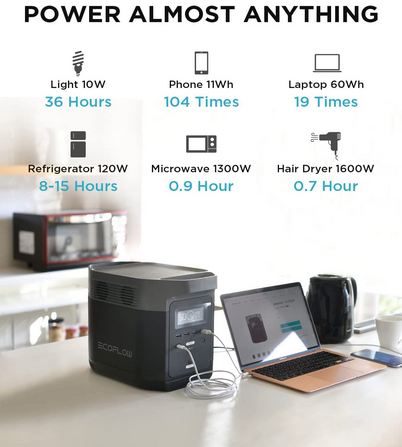
Jackery Explorer 1000
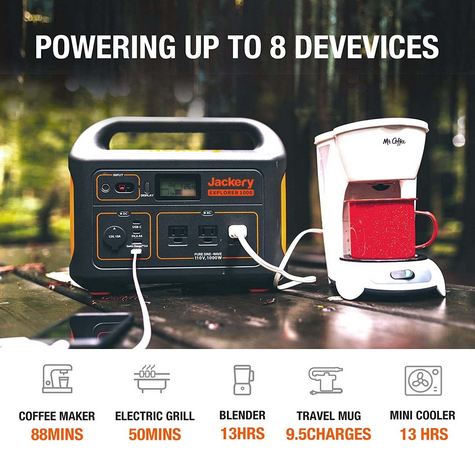
The capacity of a solar generator determines how long you can power appliances and how many times you can recharge devices.
The EcoFlow Delta 1300 has a capacity of 1260Wh, while the Jackery Explorer 1000 has a capacity of 1002Wh.
You’ll get a longer runtime from the Delta 1300. This also makes the Delta 1300 the best choice if you plan to power larger appliances or multiple appliances at the same time — it won’t drain as quickly as the Jackery 1000.
Here’s a comparison of how long each solar generator can power/charge various appliances and devices.
Appliance/device | EcoFlow Delta 1300 runtime | Jackery 1000 runtime |
|---|---|---|
Mini fridge (60W) | 17.8hrs | 14.1hrs |
Full size refrigerator (150W) | 7.1hrs | 5.6hrs |
TV (100W) | 10.7hrs | 8.5hrs |
Smartphone (10Wh) | 107 recharges | 85 recharges |
Laptop (60Wh) | 17 recharges | 14 recharges |
CPAP (40W) | 26.7hrs | 21.2hrs |
Winner: When it comes to capacity, the Ecoflow Delta 1300 is the clear winner, but not by much. If you want to power an entire RV or have backup power to last through several days of an emergency, neither power station is large enough for that.
Battery Chemistry & Lifespan
Both the EcoFlow Delta and the Jackery 1000 contain a lithium-ion battery pack.
That means they have roughly the same lifespan. Jackery says their power station is good for 500 cycles to 80% capacity while EcoFlow gives a figure of 800 cycles to 80% capacity.
Generally, with good care, you should get a total lifespan of 3-5 years from either power station.
Winner: It’s a draw. If you want a longer lasting power station, look for one with a lithium phosphate (LiFePO4) battery. These batteries typically last over 3000 cycles to 80% capacity and can have a total lifespan of 10 years.
Power Output
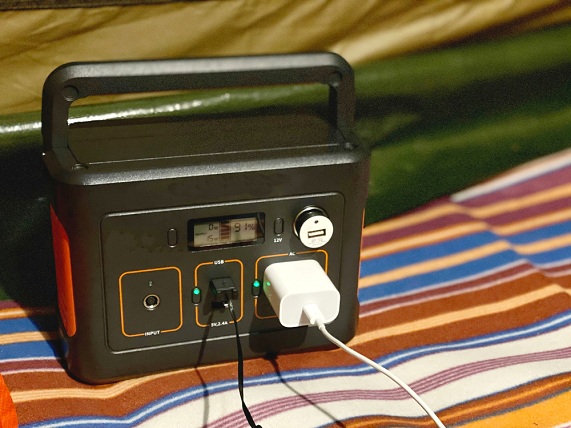
Power output is one area where there’s a big difference between the EcoFlow Delta 1300 and Jackery Explorer 1000.
The Delta 1300 produces 1800W of continuous AC power and has a surge output of up to 3300W.
In contrast, the Jackery 1000 produces 1000W of AC power and has a surge output of up to 2000W.
That’s a significant difference especially for power stations with close to the same capacity.
The Delta 1300 can power most household appliances and can also run more appliances at the same time.
The Jackery 1000 is limited to powering smaller appliances. It also cannot power more than a few appliances at the same time because of the lower load limit.
Winner: The EcoFlow Delta 1300 is the clear winner here. It’s the best pick if you want a solar generator that can power just about any household appliance and tools. It’s also ideal if you plan to power several electronics at the same time.Outlets
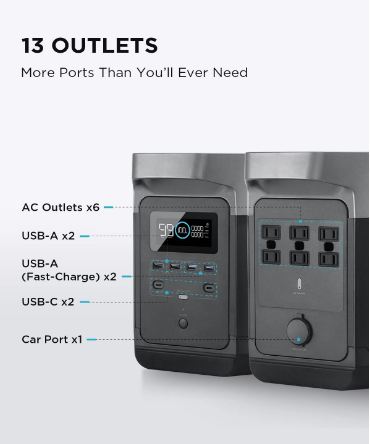
The EcoFlow Delta 1300 has 13 outlets compared to 8 outlets on the Jackery Explorer 1000.
Let’s break down all the outlets on each power station.
The Delta 1300’s output options are split among 6 AC sockets, 6 USB ports and 1 12V car port. The USB ports include two USB-A ports, two Quick Charge USB-A ports, and two 60W USB-C ports.
The Jackery Explorer has 3 AC sockets, 4 USB ports and 1 12V car port. The USB ports include one USB-A port, one Quick Charge USB-A port and two 18W USB-C ports.
The Delta 1300 has several advantages over the Jackery 1000. For one, you can power more appliances at the same time since it has more AC outlets. You can take advantage of the high power output.
Two, the Delta 1300 can charge or power more devices simultaneously with its six USB ports. Also, it can support large USB-C devices like a laptop with its more powerful 60W USB-C ports.
The Jackery 1000 has 18W USB-C outlets that are ideal only for smartphones and other small devices.
Winner: Again, the EcoFlow Delta 1300 is the clear winner. If you have or travel with multiple gadgets, the Delta 1300 is the better choice. It’s also the best pick if you plan to work off-grid with a USB-C powered laptop.
Recharging Options and Speed
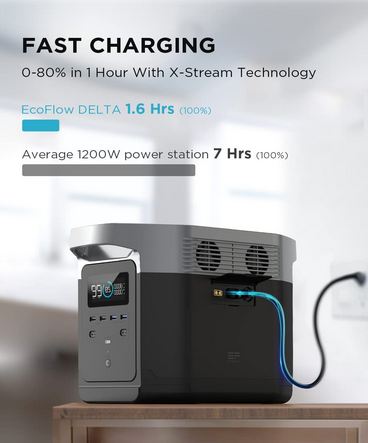
The EcoFlow Delta 1300 and the Jackery Explorer 1000 have the same number and type of input/recharging options: AC, solar and 12V/24V car port.
But there’s a big difference in how quickly they recharge.
EcoFlow is famous for their X-Stream charging technology that delivers a lot of power from a standard AC outlet.
Using the included AC charger, Delta 1300 charges from 0 to 80% in just an hour. It recharges to 100% in 1.6 hours.
In contrast, the Jackery Explorer 1000 takes about 5.5 hours to recharge via AC despite having a smaller battery.
Now let’s compare solar charging.
The EcoFlow Delta 1300 accepts up to 400W of solar power while the max input for the Jackery 1000 is 200W.
On a good sunny day, it will take the Delta 1300 about 4.5 hours to recharge from a 400W solar array. The Jackery 1000 will take about 7 hours to recharge from a 200W array.
Having a solar generator that you can fully recharge before the end of the day is handy especially when you are off-grid or outdoors. It ensures you have a full battery at night.
On most days, the Delta 1300 can recharge in a day, while the Jackery 1000 may take a couple days to fully recharge.
The slowest charging option for both power stations is using a car outlet. The Delta 1300 takes 13.5 hours while the Jackery 1000 takes 14 hours.
Winner: When it comes to recharging, the Delta 1300 wins. It charges fast via AC or solar. Notably, neither power station offers dual recharging via combined AC and solar.
Portability
One advantage of Li-ion batteries is that they are lighter and more compact thanks to their high energy density.
So both the Delta 1300 and Jackery 1000 are lighter than LiFePO4 solar generators with a similar capacity.
The Jackery 1000 is the lightest of the two. It weighs 22lbs.
The Delta 1300 weighs 30.9lbs.
Winner: The Jackery Explorer 1000 wins when it comes to portability. If you need a lightweight power station that’s easy to carry around at home or when you are outdoors, get the Jackery 1000.Price & Value For Money
Currently, the EcoFlow Delta 1300 and the Jackery Explorer 1000 cost about the same.
This makes the Delta 1300 the better value solar generator. It has more capacity, higher power output, more outlets, and faster charging than the similar priced Jackery 1000.
Winner: If you are shopping for a good deal on a mid-size solar generator, I recommend the EcoFlow Delta 1300.EcoFlow Delta 1300 Pros & Cons
Pros
Cons
Jackery Explorer 1000 Pros & Cons
Pros
Cons
EcoFlow Delta 1300 vs. Jackery Explorer 1000: Which One Should I Get?
The EcoFlow Delta 1300 is best for you if:
The Jackery Explorer 1000 is best for you if:
Bottom Line
In my opinion, the EcoFlow Delta 1300 is the better solar generator. Yes, it’s a bit heavy but not too much that you can’t lift and carry it over short distances.
Other than its slightly heavier design, it outmatches the Jackery 1000 in all other areas.
Alternatives To The EcoFlow Delta 1300 and Jackery Explorer 1000
If neither of these is what you are looking for, here are a few alternatives to consider.
EcoFlow has a new power station - the Delta 2 - that uses a longer lasting LiFePO4 battery. It has a lower capacity, but higher power output and two extra DC outlets.
Bluetti also has several LiFePO4 power stations including the Bluetti AC200P and AC200MAX.
If you need more power and capacity, Jackery has a couple of bigger siblings — the Jackery Explorer 1500 and Explorer 2000 Pro.
If you want to stick with EcoFlow, get the EcoFlow Delta Max or the Delta Pro.
If you are shopping for something smaller, lighter and cheaper, the Jackery Explorer 500 is perfect especially for camping. Or you can get the EcoFlow Delta Mini.
For other alternatives, see my reviews of the best solar generators for camping. I have also rounded up the best solar generators for home backup.

